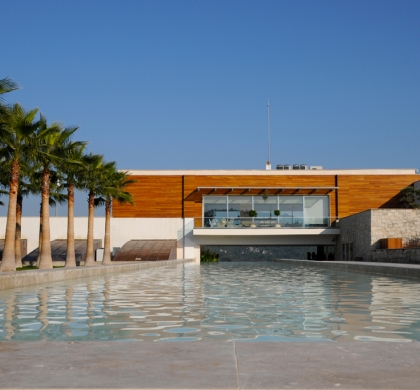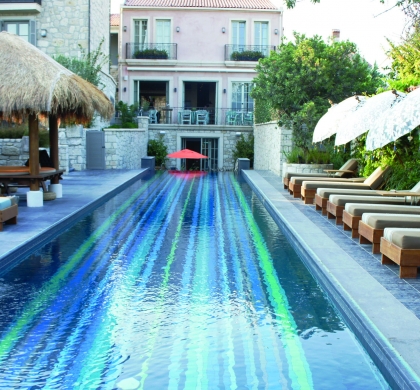Buy or gift a stand-alone digital subscription and get unlimited access to dozens of back issues for just £18.99 / $18.99 a year.
Please register at www.exacteditions.com/digital/cornucopia with your subscriber account number or contact subscriptions@cornucopia.net
Buy a digital subscription Go to the Digital EditionIt was for centuries the preserve of sultans, extolled by the ancients, sought after in the harem, a staple of palace kitchen and pharmacy. More precious than gold, mastic brought fortune and tears to the island of Chios, today the world’s sole source of this ‘Arabic gum’. Now, thanks to a pioneering initiative, the Turkish shores across the water will be green with mastic groves. Text and photographs by Berrin Torolsan
Last autumn, drawn by the aromatic scent of mastic, we headed for Çeşme, a popular resort town sitting at the tip of a peninsula of the same name, jutting out into the Aegean south of Izmir. The Çeşme Peninsula is a part of the wider Karaburun Peninsula, where winding lanes lead up onto barren hilltops with fabulous views across the strait to the Greek island of Chios. It is a beautiful but austere wedge of land with long, slanting ridges, which seems nothing more than a paradise for wind-farmers and windsurfers.
Yet concealed in shallow valleys are veritable gardens of Eden. In the centre, a trail of handmade signs leads to a maze of vineyards and some of Turkey’s best wine producers. And there is another local resource whose potential value is just as great. The climate and terrain are also ideal for the cultivation of gum mastic trees, and our purpose was to investigate new mastic plantations. Tema (the Turkish Foundation for Combating Soil Erosion), the leading national champion of natural habitats, has been pioneering a project to protect Çeşme’s existing native mastic trees and to plant new saplings. Chios, just across the water from Çeşme, produces almost all the world’s mastic. The Çeşme Peninsula has identical ecological conditions, but alas few of its mastic trees survive.
The gum mastic tree, Pistacia lentiscus, is a shrubby evergreen with deep-green foliage. Though it belongs to the pistachio genus, it is not grown for nuts, but for the aromatic resin known to the West as mastic gum, to Turks as sakız, to romantics as “tears of Chios”. Many wild forms exist across the Mediterranean, but only on Chios is mastic exploited. Indeed, such is Chios’s monopoly that to Turks it is Sakız Adası (Mastic Island).Mastic is used in toothpaste, soap and cosmetics, in some chewing gums and other confectionery, and in the varnish of musical instruments. It can be an ingredient of lokum(Turkish delight) and rakı (sakız rakısı).The resin is harvested in summer. Small cuts are scored into the bark to make the tree weep. The fluid hardens as it is exposed to air, and thtranslucent droplets are collected by hand, as they have been since prehistoric times.
The physicians of antiquity were familiar with mastic’s health-giving powers. In ancient Greece, in Rome and the later Arab world, it was valued for its digestive properties. Its essential oil, masticin, has long been used in ointments and balms, while modern science endorses its antiseptic, antibacterial and cramp-relieving effects. The first sticking plasters used mastic as a disinfectant. In recent years its age-old reputation as a remedy for intestinal troubles has been vindicated with the discovery that it cures peptic ulcers, even those resistant to strong modern drugs. In the Middle Ages, as culinary fashions followed the Arab conquests, mastic became a regular ingredient at high tables, like cinnamon, sugar or pepper, prized as much for its salutary benefits as for its flavour, securing Chios’s place in the spice trade.Over centuries Chios and its sought-after commodity were captured and recaptured. As the Byzantine Empire declined, it became a colony of Genoa, supplying the 14th-century courts of Europe.
In 1566, after nearly two centuries, the Ottomans seized the island and it became a province. Mastic-producing villages (mastika köyü) in the south, where the soil is deepest, belonged, like the crop itself, to the Sultan’s mother, the Valide Sultan, who became the islanders’ benefactor and built their mosques, fountains and libraries.The best mastic was sent to Istanbul. To ensure a constant supply, the Ottoman government protected the farmers, appointing a special governor, the Sakız Emini, and granting them tax exemption and other privileges. These they would retain until 1841, when Sultan Abdülmecid’s reforms swept away the imperial mastic monopoly along with the tax breaks.Two early French travellers who visited Chios, which they knew as Scio, drew attention to mastic’s importance in Ottoman days.
In 1701 the botanist Joseph Pitton de Tournefort, who had been sent to the Levant by Louis XIV, reported that land on the island could be bought and sold only on condition that the trees, the Sultan’s property, were preserved. Inhabitants of the 21 villages producing mastic were allowed the privilege of building bell towers for their churches and wearing white turbans, like the Turks. Tournefort noted that 286 crates of mastic, weighing 100,025 okka (around 128 tons), went to Constantinople and Izmir that year. Farmers could sell the rest, but the trade was strictly controlled. Those who did the weighing received a handful as a gratuity, but cheating, theft and smuggling were severely punished. Jean de Thévenot, writing in 1657, had observed: “Whosoever are taken stealing of Mastick, are without remission sent to the galleys.” He describes the trees as “crooked like vines, creeping along the ground”, but the “white gumm” as “of a very good scent”. Most of the island’s mastic was used to flavour breads, stews, confectionery, cakes and biscuits. Pharmacists had their share, for balms, creams, pills, soaps, syrups and potions, as well as cosmetics for the harem, where the ladies chewed mastic (related to the word “masticate”) to freshen the breath nd keep teeth clean and white – benefits confirmed by modern dentistry. The Topkapı still has its precious lidded mastic containers (sakızlık).
Byron, who visited the palace, used the gum in his manic efforts to lose weight. The palace was also, as it happens, obsessed with Swiss watches, little knowing that Swiss watchmakers depended on mastic to secure their precious enamel decoration.The gum’s commercial potential is still immense, and Chios handles the lucrative mastic business with the sophistication of the diamond trade. But in 2012 fire took a terrible toll on the island’s mastic groves, and now it can barely keep up with demand. This points up the risks of relying on one small island to supply the world’s needs, and the importance of establishing an alternative source – perhaps just across the water on the Turkish mainland.The history of Çeşme’s mastic has been one of lost opportunities. Before the Ottoman conquest of Chios, it had been the palace’s main source of the gum.
The peninsula continued to produce it until the exchange of Greek and Turkish populations in 1923. But the new settlers were tobacco growers from northern Greece with no idea of the potential of the mastic groves they had inherited.It wasn’t until 1967 that the great botanist and pharmacist Professor Turhan Baytop visited Çeşme and pioneered the notion of planting new groves there. Even then precious little happened for three decades, until Ahmet Priştina, Izmir’s popular mayor, created a nursery of 800 trees; but with his early death the project foundered.The mastic tree requires little maintenance. All you need do is prune any dead branches and clear the ground of weeds. Then, from June, you make cuts in the bark twice a week, and collect resin from July to October. For this, a single tree could earn a farmer a happy tl700 (about £180). And branches laid in trenches, in the same way as roses are grown for attar of roses, will take root naturally.
The problem is that the weeping variety of Pistacia lentiscus – the evergreen gum mastic tree – is hard to identify without DNA testing, being indistinguishable to the eye from other varieties. As it takes seven years for a young tree to start weeping nicely, you could waste years barking up the wrong tree. Wild boar are another hazard.Tema’s Mahir Keskin and his colleagues set about numbering and preserving every ancient gum mastic tree on the Çeşme Peninsula. They then created a “clone park” of grafted trees. This was no easy matter, as the weeping prevents the graft from taking, but a suitable non-weeping parent was found near Gaziantep, in the far east of the country. Around 1,000 established trees from this source will be donated to the Ministry of Forestry this year.The task requires teamwork, dedication and love, and there are several heroes in this endeavour. One is the mastic aficionado Coşkun Vural, a former importer, who now produces around 15kg a year, all of it snapped up by a mystery buyer in Ankara. His neighbour Metin Gemici has a charming line in bonsai mastic, complete with stone houses and miniature gardens.
Not only is mastic potentially lucrative; it is also an attractive shrub, long-lived and tolerant of poor saline soils and drought – ideal for seaside gardens. Everyone in the area could be planting it. With the backing of Kent Gıda, producers of the Turkish mastic-flavoured Falım chewing gum, and their owners, Mondelez International, Tema has sown the seeds of mastic’s great revival in Çeşme. May this aromatic project see these hills – beside the bluest waters, beneath the bluest skies – covered with mastic groves in the century to come.
A fascinating exhibition at the Istanbul Research Institute that explores a dog’s life in Ottoman Istanbul and the transformation of attitudes as Westernisation takes hold
Yusuf Franko Kusa used brush and pen and position to lampoon and pull the strings of Ottoman high society. Unseen for 60 years, his caricatures are now the subject of a fascinating exhibition in Istanbul, writes K Mehmet Kentel
At one time all roads led to Erzurum, a key stop on a great caravan route and a strategic bastion against invasion. Today it is a remote city on Turkey’s Asian frontier with an important history crying out to be discovered. In Part 2 of Cornucopia’s Beauty and the East series, the photographer Brian McKee continues his tour of eastern Anatolia in Erzurum as Scott Redford leads us from Turkic citadel to Mongol minarets.
An ambitious new work of classical music – based on Howard Blake’s enchanting score for ‘The Snowman’ – has just received its world premiere. This concert is just one of many achievements by Talent Unlimited, a Turkish charity that gives budding young virtuosi a helping hand. Tony Barrell tells the story. Photographs: Monica Fritz
And the award for most versatile, most nourishing and best-loved ingredient goes to… the humble chickpea. Berrin Torolsan explores its history and its limitless talent to entertain us in a multitude of different roles




Cornucopia works in partnership with the digital publishing platform Exact Editions to offer individual and institutional subscribers unlimited access to a searchable archive of fascinating back issues and every newly published issue. The digital edition of Cornucopia is available cross-platform on web, iOS and Android and offers a comprehensive search function, allowing the title’s cultural content to be delved into at the touch of a button.
Digital Subscription: £18.99 / $18.99 (1 year)
Subscribe now